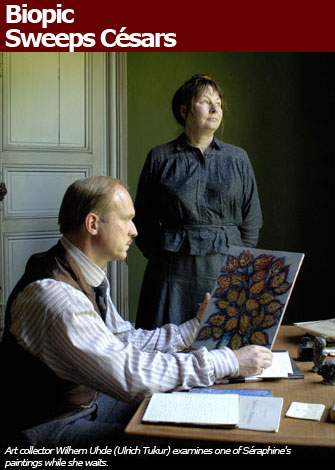
Biopics of troubled or struggling female artists seem a sure way of winning awards these days. Just think of Marion Cotillard’s star turn as Edith Piaf in La Môme (distributed as La Vie en Rose in the English-speaking world), which proved a worldwide success.
The French equivalent of the Oscars, the Césars, has just taken place, and, true to form, the big winner of the night was Martin Provost’s biopic based on the life of an early 20th-century maid-cum-painter, Séraphine of Senlis, entitled Séraphine, which won awards not only for best picture and best actress (Yolande Moreau), but also best screenplay, photography, scenery and costume.
Viewing movies about painters can be a little like watching paint dry, unless the artist spent his time doing suitably dramatic things like going insane and cutting his ear off. However, despite certain longueurs, Séraphine is a worthy victor, and Yolande Moreau’s extraordinary performance fully merits the best actress César.
I have to admit to having known next to nothing about Séraphine of Senlis before seeing this movie, but her story is a remarkable one. While leading a life of extreme hardship as a
{dmotion width=”335″ height=”260″}x6k9u7{/dmotion}
skullery maid and washerwoman, she managed to produce astounding paintings, which nobody appreciated until at the age of 48 she had the good fortune to begin working as a maid for the German art collector Wilhelm Uhde (played with understated grace in the film by Ulrich Tukur), who was staying in Senlis in the years immediately preceding World War I. Uhde was the first collector to buy a work by Picasso.
Because of the war, Uhde was forced to leave France and lost contact with Séraphine, only rediscovering her in the 1920s, when he found that her painting style had matured considerably. After a brief rise in Séraphine’s fortunes, when she was promised an exhibition in Paris and was hailed alongside Le Douanier Rousseau (also discovered by Uhde) as one of the great “primitive” artists, the worldwide financial crash at the end of the 1920s led to the proposed exhibition being cancelled and (so the movie implies) to Séraphine’s incarceration in a mental institution, where she died.
The first half hour of the film is particularly memorable as we follow Séraphine through her daily life of drudgery as she performs various tasks, including pilfering blood from a cooking pot and wax from church candles to use – as we eventually discover – to make her own paint.
Moreau’s performance as the unglamorous Séraphine is a tour de force. She convincingly conveys not only Séraphine’s simplemindedness but also the creative energy that drove her. Through the grime on her face, Moreau’s blue eyes sparkle with awareness, making Séraphine’s talent much more believable.
The other big winner at the Césars was Mesrine, another biopic, about French criminal Jacques Mesrine, with the best actor and best director gongs going to Vincent Cassel and Jean-François Richet respectively. I was particularly pleased about Agnès Varda’s award of best documentary for her wonderfully inventive film, Les Plages d’Agnès.
For full César results, go to
© 2009 Paris Update
Reader Reaction
Click here to respond to this article (your response may be published on this page and is subject to editing).
